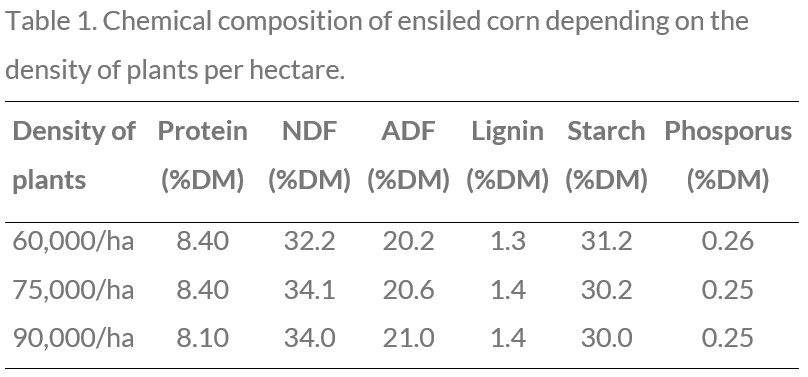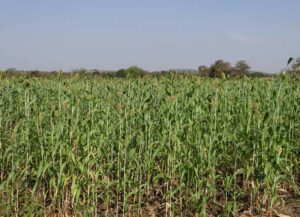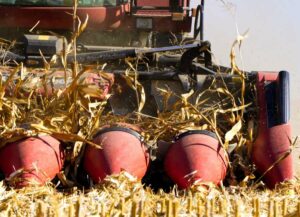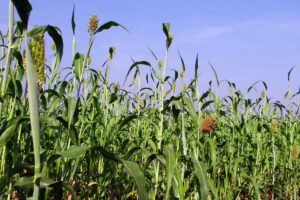Mercedes González & Fernando Diaz
Corn silage is the main source of forage on many dairy cattle farms because it provides high quality fiber of high digestibility and has a high energy density. It has high rates of intake when supplied to cows in production, with a very positive impact on milk production.
Corn forage is easy to ensile, and its cultivation provides high yields and is usually economical to grow, harvest and conserve. Therefore, many farms that have high numbers of cows and enough land, choose to grow their own crops on their farm. This allows them to have forage during several production cycles, contributing to their economic sustainability.
With corn silage it is important to maximize quality and dry matter content (DM), by harvesting the plant at its optimum maturity, which has led to establish proper cutting heights and chopping lengths. By doing this, the starch content will be adequate, and the digestibility will be optimized.
It is well known that increasing the density of corn plants increases the productive yield of ensiled forage. Some studies (Cusicanqui and Lauer, 1999) have described that higher DM production is obtained when density is increased to 98,000 plants/hectare.
Relationship between corn silage yield and quality
This increase in plant density, however, also causes a reduction in the number of kernels per plant, which decreases the concentration of starch and therefore energy in the corn silage. Some authors attribute it to nitrogen (N) deficiency probably due to competition for nutrients with plants competing through the roots, and the leaves’ photosynthesis since they do not receive enough sunlight and cannot produce enough grain.
High-density corn crops could be assumed to benefit from N fertilization, data from some studies however, indicate that a distinction should be made between the conditions under which these deficiencies occur, and when they do not, since more grain-per-plant has been obtained in N-deficient crops, but there were no differences when the crops obtained enough N from the soil.
Therefore, if forage density is increased but nutritional quality is maintained, adding N fertilizer will not have a positive impact. It will however have significant environmental implications, retaining N and phosphorus (P) in soil and water. To avoid this nutrient overload to the environment, it is essential to properly design crop nutrient management plans.
In addition, dairy farms apply systems to control nutrient overloads in water, such as reduce the amount and/or change the method and timing of fertilizer application to reduce runoff and its risk to surface water. Harvesting more biomass without affecting its N concentration reduces the risk of runoff to surface water, such that increasing crop density with proper N management can help accomplish this.
One study (Ferreira et al., 2020) assessed the effects of corn plant density on DM production, silage quality and digestibility, and soil nutrient extraction by applying different fertilization rates. The authors said that increasing corn plant density can be used strategically to increase the extraction of N and P from soil, while yielding high quality forage in dairy farms. Conventional corn varieties (CONV) and brown midrib (BMR) corn were used in this study.
Biomass production and corn maturity
Planting 90,000 plants/hectare produced 21.4 t of biomass per ha compared to 20.3 t obtained with a density of 60,000 and 75,000 plants/ha. This result was mainly attributed to the greater number of plants obtained rather than the biomass produced. The authors suggested that biomass production may be affected by plant maturity, which in turn influences the number of kernels per plant.
By doubling the dose of N fertilizer at corn V6 (6 visible leaves), the biomass increased by 3.1%. However, the differences were not significant so the effect of fertilization may not be of importance here, which had initially been attributed to the possible increase in the number of kernels per plant.
The CONV variety produced 19.2% more biomass (22.5 t/ha) than the BMR (18.9 t/ha), and this was attributed to the higher weight of the CONV plants.
The density of corn plants influenced the composition of the forage obtained as shown in table 1; differences between starch concentrations were not statistically significant. The concentration of neutral detergent fiber, acid detergent fiber and lignin increased with plant density; starch and protein decreased, and phosphorus was similar.

This study concluded that increased corn plant density and N fertilization had minimal or no effects on the composition and digestibility of corn silage. Further research on the influence of plant density and crop maturity on DM production and the nutritional composition and digestibility of corn silage is warranted.
Reference
Gonzalo Ferreira, Christy L. Teets, John B. Huffard, Matias J. Aguerre. Effects of planting population, genotype, and nitrogen fertilization on dry matter yield, nutrient composition, in vitro ruminal neutral detergent fiber disappearance, and nitrogen and phosphorus removal of corn for silage. Animal Feed Science and Technology. 2020 Oct; 268: 1-9.
© 2021 Dairy Knowledge Center. All Rights Reserved.









